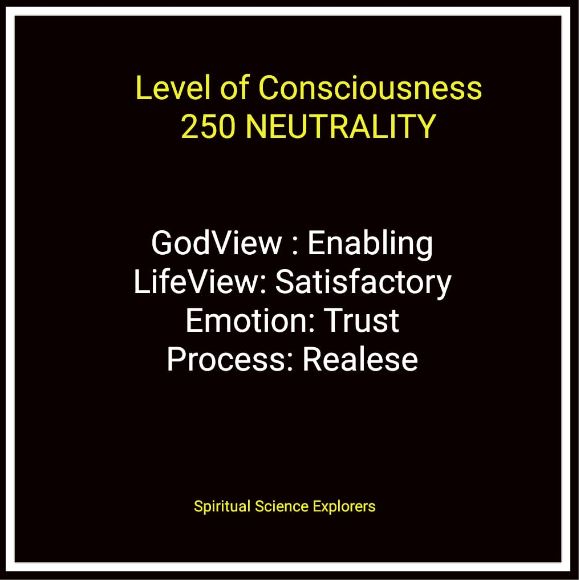Level of Consciousness 250 NEUTRALITY : Understanding David R. Hawkins' Map of Consciousness
 |
| LocC (Level of Consciousness) 250 NEUTRALITY |
The study of consciousness and its various levels has fascinated scholars and spiritual seekers alike. One prominent figure in this field is Dr. David R. Hawkins, who developed the "Map of Consciousness." This map provides a framework for understanding different levels of consciousness, ranging from lower states like shame and guilt to higher states like love and enlightenment. In this article, we will explore the level of consciousness 250, known as neutrality, according to Hawkins' Map of Consciousness.
Understanding the Map of Consciousness
Dr. David R. Hawkins' Map of Consciousness is a comprehensive model that outlines the various levels of human consciousness. It encompasses a range of emotions, attitudes, and perspectives that individuals may experience. The map is divided into levels, with each level corresponding to a specific range of emotions and thoughts. These levels start from the lowest, such as shame and guilt, and progress towards the highest, like love and enlightenment.
Level of Consciousness 250: Neutrality
At the level of consciousness 250, neutrality becomes a dominant characteristic. Neutrality refers to a state of impartiality and non-judgment, where one observes situations and experiences without attaching strong emotions or personal biases. It is a state of balance, allowing individuals to view life from a more objective standpoint.
Characteristics of Neutrality
Neutrality is marked by several key characteristics:
- Impartiality: Neutrality involves remaining unbiased and unprejudiced when observing and analyzing situations.
- Non-judgment: Individuals at this level refrain from labeling experiences as good or bad, right or wrong.
- Observation: Neutrality emphasizes the power of detached observation, enabling individuals to see beyond their personal perspectives.
- Acceptance: Those in neutrality accept circumstances as they are, without the need to control or change them.
- Open-mindedness: A neutral mindset fosters openness to new ideas, opinions, and perspectives.
The Power of Neutrality
Neutrality holds significant power in personal and spiritual growth. By adopting a neutral perspective, individuals can free themselves from the grip of strong emotions and attachments. This liberation allows for clearer thinking, enhanced decision-making, and increased self-awareness.
Cultivating Neutrality in Daily Life
To cultivate neutrality, one can practice the following:
- Mindfulness: Engaging in mindfulness exercises helps develop awareness of thoughts and emotions, creating space for neutrality.
- Meditation: Regular meditation provides a calm and centered state of mind, facilitating neutrality in daily life.
- Self-reflection: Reflecting on personal biases and judgments aids in recognizing and overcoming them.
- Empathy: Developing empathy allows individuals to understand different perspectives, fostering neutrality.
- Detachment: Learning to detach from outcomes and expectations and embracing the present moment helps cultivate neutrality in daily life.
Relationships and Neutrality
Neutrality plays a vital role in relationships, as it allows for deeper understanding and empathy. When approaching relationships from a neutral standpoint, individuals can listen and communicate more effectively, free from personal biases and judgments. Neutrality fosters harmonious connections, promotes healthy boundaries, and encourages mutual respect and acceptance.
Neutrality and Emotional Well-being
Neutrality positively impacts emotional well-being by reducing the grip of negative emotions and limiting beliefs. When individuals practice neutrality, they can observe their emotions without getting entangled in them. This practice creates space for emotional balance, resilience, and inner peace. Neutrality empowers individuals to respond to challenges with clarity and compassion rather than reacting impulsively.
Neutrality in Decision Making
The state of neutrality enhances decision-making processes by providing a clear and balanced perspective. When individuals approach decisions neutrally, they can assess situations objectively and consider various factors without being swayed by personal biases or attachments. Neutrality supports wise decision-making, fostering sound judgment and minimizing regrets.
Limitations of Neutrality
While neutrality offers numerous benefits, it is essential to acknowledge its limitations. Overemphasizing neutrality may result in emotional detachment or indifference, making it challenging to fully engage with life's experiences. It is important to find a balance between neutrality and emotional connection to maintain a rich and meaningful existence.
Advancing Beyond Neutrality
Although neutrality is a valuable level of consciousness, Dr. David R. Hawkins' Map of Consciousness highlights higher levels that individuals can aspire to. These levels, such as willingness, acceptance, and love, expand awareness and bring profound transformation. Advancing beyond neutrality involves embracing the power of love, compassion, and unity, allowing for even greater personal and spiritual growth.
Conclusion
In conclusion, neutrality, as represented by the level of consciousness 250 in David R. Hawkins' Map of Consciousness, is a state of impartiality, non-judgment, and observation. Cultivating neutrality brings balance, clarity, and emotional well-being. It enhances relationships, decision-making processes, and personal growth. While neutrality is valuable, it is important to strive for higher levels of consciousness that encompass love, acceptance, and unity. Embracing these elevated states allows individuals to experience profound transformation and a deeper connection with themselves and the world around them.
Post a Comment for "Level of Consciousness 250 NEUTRALITY : Understanding David R. Hawkins' Map of Consciousness"